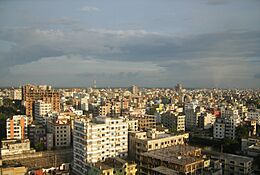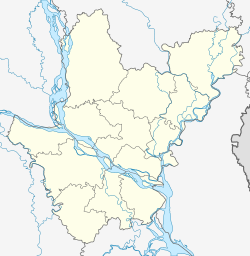Narayanganj facts for kids
Quick facts for kids
Narayanganj
নারায়ণগঞ্জ
|
|
|---|---|
|
From top: City Skyline, Port of Narayanganj,
Tomb of Sultan Ghiyasuddin Azam Shah , Baro-Bhuyan Palace of Lord Isa Khan, Historical Panam City, Hajiganj Fort in City East |
|
| Country | |
| Division | Dhaka |
| District | Narayanganj |
| Municipal Board | 8 September 1876 |
| Metropolitan city | 5 May 2011 |
| Government | |
| • Type | Mayor–council government |
| • Body | Narayanganj City Corporation |
| Area | |
| • Metropolis | 33.57 km2 (12.96 sq mi) |
| • Water | 48.56 km2 (18.75 sq mi) |
| • Metro | 72.43 km2 (27.97 sq mi) |
| Elevation | 3 m (10 ft) |
| Population
(2022)
|
|
| • Metropolis | 967,951 |
| • Density | 28,834/km2 (74,679/sq mi) |
| Time zone | UTC+6 (Bangladesh Time) |
| Postal code |
1420
|
| Area code(s) | 0671 |
| Calling Code | 02 |
Narayanganj (pronounced Naraeongônj) is a busy city in central Bangladesh. It's part of the larger Dhaka area. You can find it about 16 kilometers (10 miles) southeast of Dhaka, which is the capital city. Narayanganj is home to almost 1 million people, making it the 6th largest city in Bangladesh. It's a very important place for business and factories, especially for processing jute and making textiles. Because of its many jute factories, people sometimes call it the Dundee of Bangladesh. Dundee was a city in Scotland known for its jute industry.
History of Narayanganj
How Narayanganj Got Its Name
The city of Narayanganj got its name from a religious leader named Bicon Lal Pandey. He was also known as Benur Thakur or 'Lakshmi Narayan Thakur'. In 1766, after the Battle of Plassey, he rented this area from the British East India Company. He gave the markets and land by the river as Devottor property. This means it was 'Given to God' to help pay for the worship of the god Narayan.
Early Developments in the City
Over time, Narayanganj grew. A post office was set up in 1866. A telegraph service, which sent messages over long distances, started in 1877. The first telephone service in the city began in 1882.
Becoming a Municipality
Narayanganj officially became a municipality on September 8, 1876. The first hospital in the area, Narayanganj Victoria Hospital, was built in 1885. The municipality helped pay for it, along with money from Harakanta Banerjee.
Modern City Corporation
On May 5, 2011, the Narayanganj City Corporation was formed. This new corporation brought together three smaller municipalities: Narayanganj, Siddhirganj, and Kadam Rasul. The mayor of Narayanganj City Corporation is Selina Hayat Ivy. Before this, she was the mayor of the Narayanganj Municipality.
People and Population
Population Growth in Narayanganj
According to a count done in 2011, Narayanganj City Corporation had 709,381 people living in 165,637 homes. About 19.47% of the people were under 10 years old. The city's population grew to 967,951 by 2022.
Education and Literacy
In 2011, the literacy rate (meaning people aged 7 and older who could read and write) in Narayanganj was 66.37%. This was higher than the national average for Bangladesh, which was 51.8%.
| Religions in Narayanganj City Corporation (2011) | ||||
|---|---|---|---|---|
| Religion | Percent | |||
| Islam | 91.22% | |||
| Hinduism | 8.71% | |||
| Other or not stated | 0.07% | |||
Religions in the City
The main religions in Narayanganj are Islam and Hinduism. In 2011, about 91.22% of the people were Muslim, and 8.71% were Hindu. A very small number of people followed other religions.
Getting Around Narayanganj
Railway Connections
Narayanganj has two train stations: Chashara railway station and Narayanganj railway station. These stations help people travel to and from the city by train.
Roadways and Buses
If you are coming from Dhaka, there are three main roads to enter Narayanganj. These are the Dhaka–Narayanganj old road, the Dhaka–Narayanganj link road, and the Narayanganj–Demra road. The BRTC AC Bus service also provides comfortable bus transport between Narayanganj and Dhaka.
See also
 In Spanish: Narayanganj para niños
In Spanish: Narayanganj para niños










